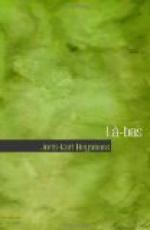“This is a real chapel, isn’t it?” he asked.
“Yes. This house, this church, the garden that we crossed, are the remains of an old Ursuline convent. For a long time this chapel was used to store hay. The house belonged to a livery-stable keeper, who sold it to that woman,” and she pointed out a stout brunette of whom Durtal before had caught a fleeting glimpse.
“Is she married?”
“No. She is a former nun who was debauched long ago by Docre.”
“Ah. And those gentlemen who seem to be hiding in the darkest places?”
“They are Satanists. There is one of them who was a professor in the School of Medicine. In his home he has an oratorium where he prays to a statue of Venus Astarte mounted on an altar.”
“No!”
“I mean it. He is getting old, and his demoniac orisons increase tenfold his forces, which he is using up with creatures of that sort,” and with a gesture she indicated the choir boys.
“You guarantee the truth of this story?”
“You will find it narrated at great length in a religious journal. Les annales de la saintete. And though his identity was made pretty patent in the article, the man did not dare prosecute the editors.—What’s the matter with you?” she asked, looking at him closely.
“I’m strangling. The odour from those incense burners is unbearable.”
“You will get used to it in a few seconds.”
“But what do they burn that smells like that?”
“Asphalt from the street, leaves of henbane, datura, dried nightshade, and myrrh. These are perfumes delightful to Satan, our master.” She spoke in that changed, guttural voice which had been hers at times when in bed with him. He looked her squarely in the face. She was pale, the lips pressed tight, the pluvious eyes blinking rapidly.
“Here he comes!” she murmured suddenly, while women in front of them scurried about or knelt in front of the chairs.
Preceded by the two choir boys the canon entered, wearing a scarlet bonnet from which two buffalo horns of red cloth protruded. Durtal examined him as he marched toward the altar. He was tall, but not well built, his bulging chest being out of proportion to the rest of his body. His peeled forehead made one continuous line with his straight nose. The lips and cheeks bristled with that kind of hard, clumpy beard which old priests have who have always shaved themselves. The features were round and insinuating, the eyes, like apple pips, close together, phosphorescent. As a whole his face was evil and sly, but energetic, and the hard, fixed eyes were not the furtive, shifty orbs that Durtal had imagined.
The canon solemnly knelt before the altar, then mounted the steps and began to say mass. Durtal saw then that he had nothing on beneath his sacrificial habit. His black socks and his flesh bulging over the garters, attached high up on his legs, were plainly visible. The chasuble had the shape of an ordinary chasuble but was of the dark red colour of dried blood, and in the middle, in a triangle around which was an embroidered border of colchicum, savin, sorrel, and spurge, was the figure of a black billy-goat presenting his horns.




